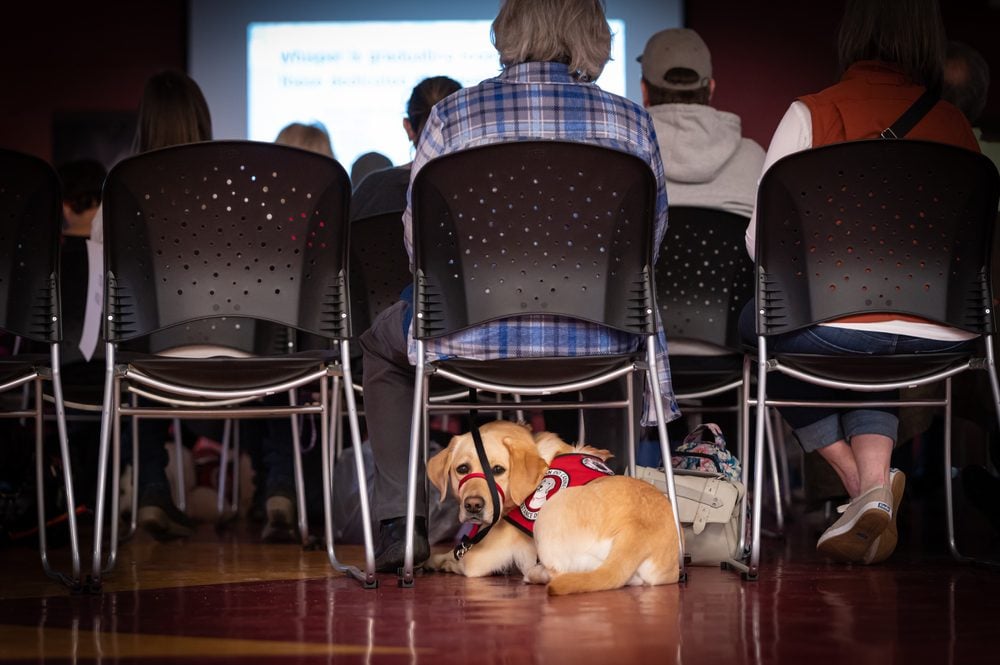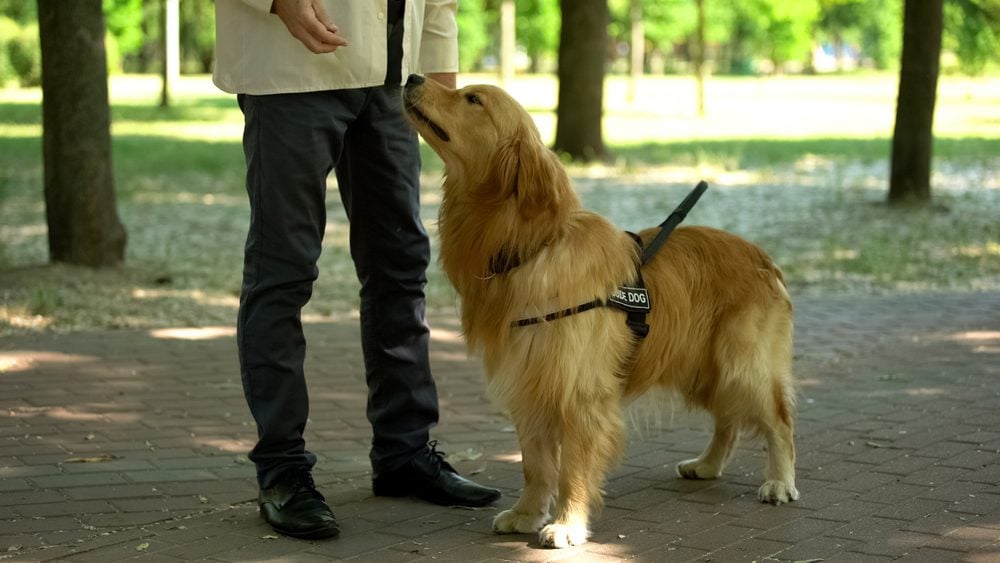Service dogs are an amazing tool for those with autism and serve as unique companions for individuals that need support throughout their daily lives. However, service dogs may be expensive when purchased outright, and some individuals may not have the means to obtain a fully trained autism service dog. In these cases, training your own autism service dog is a great alternative that builds a strong bond between the handler and their canine companion.
Our article helps you understand what to consider before you embark on the process of training your own autism service dog. We give you pointers on what to look for when it comes to a suitable service dog and give you advice on starting service dog training for your pup.
Why Train a Service Dog?
Service dogs are incredibly helpful for those with disabilities, but they can be expensive when it comes to adopting a fully trained service dog. As a result, many individuals choose to train a service dog instead of purchasing one to cut costs. Training your own service dog can also be quite bonding for the individual and their companion, leading to more confidence and higher chances of a positive service dog experience both in public and around the home.
What’s the Cost of Training a Service Dog Yourself?
Training a service dog yourself costs much less than adopting a fully trained service dog. In general, adoption fees at local rescues and shelters will range between nothing and a few hundred dollars, depending on the location and organization. If you choose to adopt a certain breed to act as a service dog, you will likely need to go through a breeder and will pay anywhere between a few hundred and a few thousand dollars, which is also dependent on your location, the breeder, and the breed of dog you are interested in.
After you have adopted your dog, you will need to ensure you have proper caretaking items such as food and water bowls, toys, and any other training materials. Training is typically low-cost or free, depending on the resources you use. The only reoccurring cost you must pay is for regular veterinary visits to ensure your pup is in good health – a service dog must be healthy and happy to complete their tasks.
You can learn more about the exact costs of adopting a fully trained service dog versus training a service dog yourself here.
Service Dogs vs. Emotional Support Animals
Many individuals might use these terms interchangeably, but they actually refer to different categories of dogs. For example, service dogs are specifically trained to help individuals with a disability; they have certain tasks to complete that directly help relieve symptoms of a disability or support their handler as they progress through their day.
On the other hand, emotional support animals are any animal, not just dogs, that aren’t necessarily trained to perform specific tasks that help with a disability but provide support and comfort to those suffering from conditions such as depression, anxiety, or PTSD.
The main difference between service dogs and emotional support animals are the public access rights that they are granted. Service dogs are protected in most places by the Americans with Disabilities Act (ADA), while emotional support animals have limited protections that mostly deal with housing.
You can read more about the difference between these two categories of assistance animals here.
Considerations When Training an Autism Service Dog
Before you get to work training your dog to be an autism service dog, there are a few things that you need to consider. These items are all important aspects of determining whether or not the dog you are trying to train is a good candidate for service dog work.
Breed and Temperament
The breed and temperament of the dog you are trying to train are incredibly important to pay attention to. While any dog has the potential to be trained as a service dog, certain breeds are much more adaptable to service dog work, such as golden retrievers, poodles, and German shepherds. These breeds are calm, confident, eager to learn, and have the size that allows them to support most disabilities.
If you are interested in adopting a mixed breed dog or one that’s outside of typical service dog breeds, this is possible. Still, you will want to ensure that the dog you have in mind is calm, confident, properly socialized, and adaptable.
Ideal service dogs are easygoing, eager to learn, and easily trainable. Additionally, they should not be aggressive or anxious in any way, as these behaviors can make them unsafe for both the handler and public spaces.
Openness to Training
Being open to training is an important step in this process for both you and your potential service dog. Selecting a dog that is eager to learn and not stubborn is essential, as stubbornness and willful behavior won’t make for a good service dog. However, you should also note that training an autism service dog is a time-intensive process – you will need at least 120 hours of training spread out over six months, with more hours added for public training and specialized skills as necessary.
You will need patience and consistency to ensure your service dog learns the proper tasks, and they will need a positive attitude toward training for this process to work.
Limitations and Needs
As you decide on a dog to adopt or evaluate a dog you already own for service dog training, keep in mind your dog’s limitations and your own service needs. If your dog is older and has medical issues, has a history of aggression, or doesn’t take training well, they might not be the best choice for a service dog.
You should also evaluate your dog’s size, skill at retrieving items, and ability to listen to you for basic tasks. Larger dogs may be a better choice when it comes to training for an autism service dog role, as these pups can provide deep pressure therapy to calm an individual and guide and support a person when necessary. Smaller dogs will have a harder time with all of these tasks.
Teaching Your Autism Service Dog the Basics



As you start the process of training your autism service dog, it’s important to establish the basics. The following are essential steps you need to work on with your dog before you move on to more specialized tasks that help train your dog to be an autism service dog specifically.
You can also reference the public access test for service dogs to see what a properly socialized and obedient service dog looks like—these are the skills your dog should have in addition to any specialized tasks to help support someone with autism.
Socialization
Proper socialization is essential for your autism service dog. Any service dog must remain calm and confident when in public, at home, or when presented with new situations. Socialization typically happens in puppyhood, and your dog should be exposed to different people, new sounds, taught to be alone, and interact solely in a gentle and friendly manner. This will produce a calm, confident dog as they grow older.
Obedience Skills
Basic obedience skills are a must for your autism service dogs. These skills help you maintain better command over your service dog and are often foundational for more advanced tasks. For example, sit, stay, come, and lay down are all great commands when you begin training your dog.
Basic Manners
Basic manners can sometimes include obedience skills but generally refers to how your service dog acts in public or around others. Your service dog should be ok with sitting and waiting for long periods as they accompany you throughout the day, and they should listen attentively to you for what to do next. They shouldn’t be aggressive, overly exuberant to others in public, steal food, or react anxiously to new situations.
You can train basic manners at the same time you are teaching your dog essential obedience commands.
Leash Training
Leash training is another important thing for service dogs to learn. Your autism service dog must be comfortable listening to you and either following or guiding both on-leash and off-leash. They will need to have the discipline to listen if they are off-leash, and they must not run away or otherwise act out.
Specialized Tasks for Autism Service Dogs
Below, we list some specialized tasks you may want to train your autism service dog to complete. Online resources can help you get started on this training, and you may want to consult online training courses for assistance with more specialized skills or troubleshooting training problems.
- Deep pressure therapy
- Assistance with meltdowns or overstimulation
- Reduction of and distraction from repetitive or stimming behavior
- Grounding
- Tethering and tracking
- Blocking exits that an individual might accidentally find their way through into more dangerous environments
- Communication with EMS and other medical authorities via guiding and retrieving packets of information
- Providing comfort and a sense of routine
Keep in mind that this list isn’t comprehensive and that you might need to train other tasks for your autism service dog to complete. Everyone is different with their own unique needs, so it’s helpful to jot down a complete list of the tasks you will need your autism service dog to learn before training, so you know where to start and which skills to build on.
When to Consult a Dog Training Professional
Occasionally, you may need to consult a professional to help you stay on track with your dog’s training or to troubleshoot certain training issues. A professional might also help you get started with the training of more specialized or advanced tasks that you are having difficulties finding resources on training online.
It’s important to note that a professional dog trainer will cost about $50 to $250 an hour depending on the tasks you need help training and your dog’s overall temperament (more aggressive or stubborn dogs are typically harder to train and will cost more).
You can reach out to local dog trainers for consultations and an accurate estimate of costs.
Do You Need to Register Your Service Dog?
Though many people use vests and other items to clearly mark their dog as a service animal, this isn’t necessary. The ADA has no requirements for training your service dog or registering them. There are also a very limited set of questions about what can be asked of you and your service dog. More information on this can be found here.
Ensuring You Have a Service Dog for Your Needs
Training your own autism service dog is no small task, but this process can encourage a strong bond between a service dog and their handler, not to mention, more cost-effective overall. If you’re dedicated to training your own autism service dog, keep in mind the tasks you need completed, the best breeds for this type of service work, and ensure you have enough time to dedicate to training.
Consistent training, lots of patience, and a calm, eager-to-learn dog will ensure that you have an autism service dog that meets your exact needs in no time.
